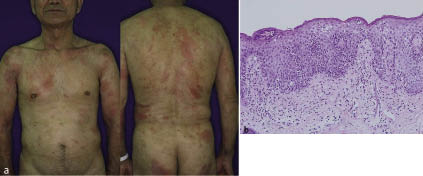Tomomitsu Miyagaki1, Makoto Sugaya1, Yosaku Minatani1, Hideki Fujita1, Akira Hangaishi2, Mineo Kurokawa2, Yutaka Takazawa3 and Kunihiko Tamaki1
Departments of 1Dermatology, 2Hematology & Oncology, and 3Pathology, Faculty of Medicine, University of Tokyo, 7-3-1 Hongo, Bunkyo-ku, Tokyo 113-8655, Japan. E-mail: miyagakit-der@h.u-tokyo.ac.jp
Accepted February 16, 2009.
Sir,
Mycosis fungoides (MF), a common form of primary cutaneous T-cell lymphoma (CTCL), is a type of to non-Hodgkin’s lymphoma (HL). Although the coexistence of multiple distinct lymphoid neoplasms in the same individual is rare, cases of CTCL associated with HL or other types of non-Hodgkin’s lymphoma have been described previously (1–3). We report here a rare case of MF associated with a composite recurrent HL and diffuse large B-cell lymphoma (DLBCL).
Case Report
A 75-year-old Japanese man was referred to our hospital with scaly erythematous plaques distributed over most of his body. The patient had a history of nodular-sclerosing subtype HL diagnosed at the age of 62 years with persistent fever and left axillary lymph node swelling. Biopsy specimens from axillary lymph nodes showed a pleomorphic cellular infiltrate with bands of fibrosis and contained numerous large atypical cells, including Reed-Sternberg cells and lacunar cells (Fig. 1a). Immunohistochemistry and in situ hybridization showed that the Reed-Sternberg cells were positive for CD30 and Epstein-Barr virus-encoded RNA (EBER) and negative for CD20. In addition, T-cell markers were negative. These features confirmed the diagnosis of nodular-sclerosis subtype of HL. He was treated with polychemotherapy (cyclophosphamide, vincristine, procarbazine and prednisolone) combined with radiation therapy and complete remission was achieved. His medical history was otherwise unremarkable.
Fig. 1. (a) Hodgkin’s disease, nodular sclerosis at the age of 62 years (haematoxylin-eosin stain ×200). (b) Hodgkin's disease, recurrence (×100). (c) Infiltration of large-sized centroblasts (×600).
At presentation, scaly erythematous patches and infiltrated plaques were distributed over most of the patient’s body (Fig. 2a). The skin lesions had initially appeared at the age of 64 years on his left arm and the number of lesions increased year after year. He had no lymphadenopathy. Histological examination of a skin biopsy specimen from the left shoulder revealed infiltration of small lymphocytes with only subtle nuclear atypia in the epidermis and superficial dermis (Fig. 2b). Immunohistochemical study showed that these atypical cells were positive for CD3 and CD4, but negative for CD20 and CD30. Southern blotting analysis of T-cell receptor gene using DNA from lesional skin detected a monoclonal rearrangement band. Further detailed examination revealed no visceral, lymph node, or blood involvement. The patient was diagnosed with MF, T2bN0M0B0, clinical stage Ib.
Fig. 2. (a) Scaly erythematous patches and infiltrated plaques all over the body. (b) Infiltration of small lymphocytes with only subtle nuclear atypia in the epidermis and superficial dermis (×200).
The skin lesions were treated with oral psoralen-ultraviolet A (PUVA) therapy and topical corticosteroid, resulting in partial improvement. The skin lesions remained stable thereafter. Three years after the diagnosis of MF, a subcutaneous mass (3.5 × 3.0 cm) appeared on the patient’s left lower abdomen. He also developed swelling of multiple lymph nodes, ranging from the aortic bifurcation region to the bilateral inguinal region. Biopsy specimens from the inguinal lymph nodes showed almost the same pathological findings as those from axillary lymph nodes at the age of 62 years (Fig. 1b). In addition, there was a lesion composed of diffuse infiltration of large-sized centroblasts (Fig. 1c). Most large atypical lymphocytes were positive for CD30 and negative for CD20 and CD4. By contrast, centroblasts were CD20-positive and CD30-negative. Large cell transformation of MF was denied because both large atypical lymphocytes and centroblasts were negative for T-cell markers. These findings were compatible with a composite lymphoma with relapse of HL and DLBCL, stage IIb. We could not analyse the clonal relationship between the two lymphomas because of the lack of agreement with genetic cloning of the patient. He received six cycles of rituximab-CHOP (cyclophosphamide, doxorubicin, vincristine and prednisolone) therapy, and a complete remission of the relapsed HL and DLBCL was achieved. In addition, the skin lesions of MF improved partially during the chemotherapy. After the chemotherapy, however, his MF began to deteriorate gradually with extensive patches and plagues and the development of nodules. Although the HL and DLBCL were still in remission, the patient died of MF at the age of 81 years (3 years after the diagnosis of a composite lymphoma with the relapse of HL and DLBCL).
Discussion
Patients with CTCL are known to have an increased risk of developing second malignancy, especially lymphoid neoplasms of different lineages (1–3). On the other hand, it is well known that patients with HL are at increased risk of developing second malignant neoplasms including non-Hodgkin’s lymphoma (4–6). Occurrence of MF in patients with previous HL has also been reported occasionally (7).
Various explanations for the coexistence of different lymphomas in an individual have been proposed (4, 8), such as a genetic predisposition for malignancies (9). In our case, the patient’s father had died of gastric cancer. It has been suggested that underlying viral infection may result in multiple lymphoproliferative disorders (10, 11). While our patient was negative for HTLV-1 and HIV antibodies, tumour cells of HL were positive for EBER. Furthermore, the mutagenic effects of cytostatic drugs have been assumed to be involved in the pathogenesis (12). In our patient, MF occurred after polychemotherapy combined with radiation therapy for HL. Patients with HL, advanced MF and Sézary syndrome are reported to have impaired immunity with an altered cytokine profile (13, 14). It was also possible that HL and CTCL were derived from the same pluripotent stem cells, which had a dual capacity for evolution of T and B cells. Although immunohistochemical staining for stem cell markers was not performed in our case, some reports have described a common clonal origin of CTCL and other types of lymphoma (15).
References





